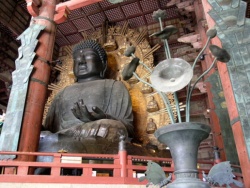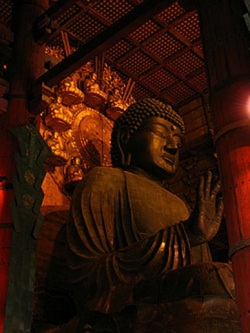Nam(u) Myōhō Renge Kyō
Nam Myōhō Renge Kyō (南無妙法蓮華經, also Namu Myōhō Renge Kyō; To Honour/devote oneself to the Wonderful Law of the Lotus Sutra or Glory to the Sutra of the Lotus of the Supreme Law! is a mantra that is chanted as the central practice of all forms of Nichiren Buddhism. The mantra is referred to as daimoku (題目 ) or, in honorific form, o-daimoku (お題目) and was first revealed by the Japanese Buddhist teacher Nichiren on the 28th day of the fourth lunar month of 1253 CE at Seichō-ji (also called Kiyosumi-dera) near Kominato in current-day Chiba, Japan. The practice of chanting the daimoku is called shōdai (唱題). The purpose of chanting daimoku is to attain perfect and complete awakening (enlightenment).
Meaning
As Nichiren explained the mantra in his Ongi Kuden (御義口傳), a transcription of his lectures on the Lotus Sutra, Nam(u) (南無) is a transliteration into Japanese of the Sanskrit "namas", and Myōhō Renge Kyō is the Japanese pronunciation of the Chinese title of the Lotus Sutra, in the translation by Kumārajīva (hence, Daimoku, which is a Japanese word meaning 'title').
Nam(u) is used in Buddhism as a prefix expressing the taking of refuge in a Buddha or similar object of veneration. In Nam(u) Myōhō Renge Kyō, it represents devotion or conviction in the Mystic Law of Life as expounded in the Lotus Sutra, not merely as one of many scriptures, but as the ultimate teaching of Buddhism, particularly with regard to Nichiren's interpretation. The use of Nam vs. Namu is, amongst traditional Nichiren schools, a linguistic but not necessarily a dogmatic issue, since u is devoiced in many varieties of Japanese.
The Lotus Sutra is held by Nichiren Buddhists, as well as practitioners of the Chinese Tiantai (T'ien-t'ai) and corresponding Japanese Tendai sects, to be the culmination of Shakyamuni Buddha's 50 years of teaching. However, followers of Nichiren Buddhism consider Myōhō Renge Kyō to be the name of the ultimate law permeating the universe, and the human being is at one, fundamentally with this Law and can manifest realization, or Buddha Wisdom (attain Buddhahood), through Buddhist Practice.
Broken down, Myōhō Renge Kyō consists of:
Myō (妙) meaning 'strange', 'mystery', 'miracle', cleverness',
Hō (法) meaning 'law', 'principle', 'doctrine',
Myōhō (妙法) meaning 'supreme (marvelous law of Buddha',
Ren (蓮) meaning 'lotus',
Ge (華) meaning 'flower' and
Kyō (経) meaning 'sutra' or 'teaching'.
"Nam" (南) meaning 'south'
The seven characters na-mu-myō-hō-ren-ge-kyō are written down the centre of the Gohonzon, the mandala venerated by most Nichiren Buddhists. (The veneration towards the mandala should be understood as the veneration for what it represents: the Buddha Nature inherent to our life).
Precise interpretations of Nam(u)-Myōhō-Renge-Kyō, how it is pronounced, and its position in Buddhist practice differ slightly among the numerous schools and sub-sects of Nichiren Buddhism, but "I take refuge in (devote or submit myself to) the Wonderful Law of the Lotus Flower Sutra" might serve as a universal translation.
Daimoku and the Three Great Secret Dharmas
The (O)daimoku is the first of the Three Great Secret Dharmas (Laws) (三大秘法) (J. sandai-hihō) revealed by Nichiren. The other two being the Gohonzon, and the Kaidan (Precept Platform).

